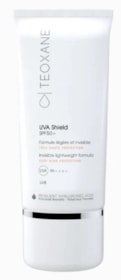Each summer, work-weary, sun-starved Brits look forward to baking under a hot foreign sun, wearing nothing but a piece of lycra or two, and a thin layer of suncream.
But what are the facts about sunburn and sunscreens?
Sunburn has two components: The initial ‘burn’ is unpleasant enough, but the long term damage is more serious, including skin cancer and (quelle horreur) wrinkles and saggy skin.
Sunburn is caused by UVB ultraviolet light-waves. They also release free-radicles, which damage skin-cell DNA, and hence can cause skin cancer. On the plus side, they trigger late tanning.
UVA waves penetrate deeper. They tan (nice), but age the skin (bad), and also contribute to skin cancer (very bad).
A sun-tan is our skin’s natural sunscreen, but doesn’t prevent damage from prolonged sunbathing, hence the need for commercial sunscreens. These either form a barrier to, or absorb UV.
But which to choose?
Check the ‘Sun Protection Factor’ (SPF). SPF 15 delays burning by 15-fold (eg from 20 minutes to 5 hours) and filters 93% of UVB. SPF 30 delays burning by 30-fold and filters 97% of UVB.
UVA protection uses a star system (1 to 5). This indicates protection relative to UVB, so 5 stars for SPF 15 is less than 5 stars for SPF 50. European labelling will change soon, to a simpler ‘Low’ to ‘Very high’.
You should apply at least 2mg/cm2 exposed skin. For those who don’t pack mini-scales and a planimeter with their beach-towels, this means the average adult needs around two table-spoons. Apply at least 20 minutes before sun exposure, and reapply 2 hourly, or after swimming/sweating/towelling yourself, even for water-resistant products. Some swimwear (Spinali Design) contain UV sensors to remind you, via your smartphone, when to reapply.
Some sunscreen ingredients have safety question-marks. Oxybenzone have oestrogen-like effects and retinyl palmitate causes cancer in rats (both, at high doses). Some sunscreens actually increase free-radicle release in the skin.
These safety concerns may not be material in practise, but, regardless, using sunscreens isn’t carte blanche for excessive sun-worship. They don’t give 100% protection, and limiting intense sun exposure, by wearing hats and sun-protective clothing is also necessary. Consider UV-filter sunglasses too, as UV can cause cataracts.
Our skin uses sunlight to make vitamin D, and excessive sunscreen use can interfere. Vitamin D may help prevent cancer. Although it is present in some foods, skin production is still important.
How about sun-tan alternatives? Tanning beds frequently expose users to even more UV than natural sunlight and should be avoided.
Many ‘self-tans’ use chemicals which react with skin protein, turning them dark. They’re probably safe, but can also enhance free-radicle production in skin, so you must use sunscreen after them.
The verdict? Do use sunscreen, and do enjoy the sun, but be sensible and stay safe.
Next time I’ll advise on treating sunburn, and discuss long-term effects of too much sun.
Further Information:
http://www.nhs.uk/Conditions/Sunburn/Pages/Introduction.aspx
https://www.aad.org/media-resources/stats-and-facts/prevention-and-care/sunscreen-faqs
Note: These articles express personal views. No warranty is made as to the accuracy or completeness of information given and you should always consult a doctor if you need medical advice




